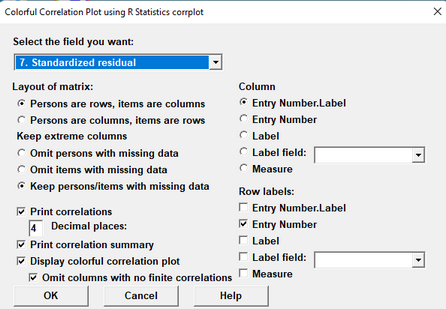This performs the specified G-Theory analysis using the R Statistics package "gtheory"
|
|
Instructions for Brennan.3.2.txt G-Theory Analysis |
Instructions for Rajaratnam.2.txt G-Theory Analysis |
Define G-Theory Model |
a Generalizability G-Study and a Decision D-study are specified and performed |
Measurement facets; (or factors) (any facet. Default is all facets.) |
the facets used to explain the variance in the data |
Select interactions (any pair of facets. Default is none,() |
the facet interactions used to explain the variance in the data. Can specify facets not checked as Measurement facets. |
Score variable. (Default is Observation) (one of Obs, Stp, Exp, Res, Var, StRes, Wt, LProb, Meas, Disp, MPCat) |
the raw data in the Residual file whose variance is to be explained. Examples: the observations, the standardized residuals. See Residual File |
Object of Measurement (any facet. Default is first facet.) |
the facet whose Generalizability (Reliability) is to be estimated. This is automatically added to the Measurement facets, if not checked there. |
Strata facet (any facet. Default is none.) |
facets which defines strata in the data, such as subtests of items, content strands. Can specify a facet not checked as a Measurement facet. |
R Statistics package "gtheory", described in cran.r-project.org/web/packages/gtheory/gtheory.pdf, is launched from this window. It is based on Brennan, R. L. (2001). Generalizability theory. New York: Springer, and Rajaratnam, N., Cronbach, L. J., & Gleser, G. C. (1965). Generalizability of stratified-parallel tests. Psychometrika, 30(1), 39-56. It includes example datasets: data(Brennan.3.2) and data(Rajaratnam.2). These are slightly reformulated as Facets example datasets: Brennan.3.2.txt and Rajaratnam.2.txt. No changes are made to the observations, but the element numbers differ resulting in some differences in the output of "gtheory".
Example: "gtheory" output for Brennan.3.2.txt in the Examples folder:
Brennan.3.2.txt Facets specifications:
Title= G-Theory Brennan.3.2
Facets = 3
Models = ?,?,?,R9
Positive = 1,2,3
Noncenter=2
Labels=
1, Task
1-3
*
2, Person
1-10
*
3, Rater, G ; group anchoring: each rater rated one task
1_4, Group 1, 0, 1
5-8, Group 2, 0, 2
9-12, Group 3, 0, 3
*
data=
; Task Person Rater Score
1 1 1 5
1 2 1 9
................
With 2 facets: (omitting tasks):
source var percent n
1 Rater 0.8840014 20.6 1
2 Person 0.6257537 14.6 1
3 Residual 2.7872078 64.9 1
$generalizability
[1] 0.7292988
With 3 facets (raters are nested within task):
source var percent n
1 Rater 0.6068375 13.8 1
2 Person 0.6257565 14.2 1
3 Task 0.3811112 8.7 1
4 Residual 2.7872049 63.3 1
$generalizability
[1] 0.7292999
With 3 facets and interactions:
source var percent n
1 Task:Person 0.5595713 12.8 1
2 Task:Rater 0.2952631 6.7 1
3 Rater 0.3522727 8.0 1
4 Person 0.4731462 10.8 1
5 Task 0.3251216 7.4 1
6 Residual 2.3802471 54.3 1
$generalizability
[1] 0.5514371

